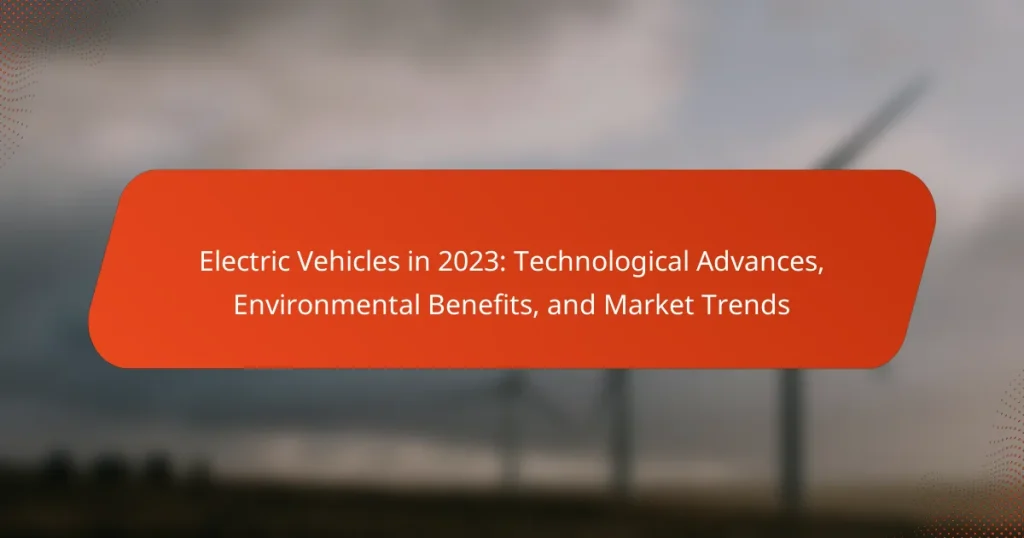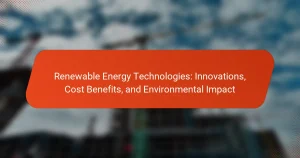Electric vehicles (EVs) are automobiles powered wholly or partially by electricity, utilizing electric motors instead of internal combustion engines. In 2023, EVs are crucial for reducing greenhouse gas emissions and improving air quality, with zero tailpipe emissions. The global market for EVs is experiencing significant growth, with sales projected to reach 26 million units by 2030, driven by advances in battery technology and government incentives. Despite this growth, challenges such as limited charging infrastructure, high costs, and competition from traditional vehicles persist, impacting consumer adoption and market expansion.
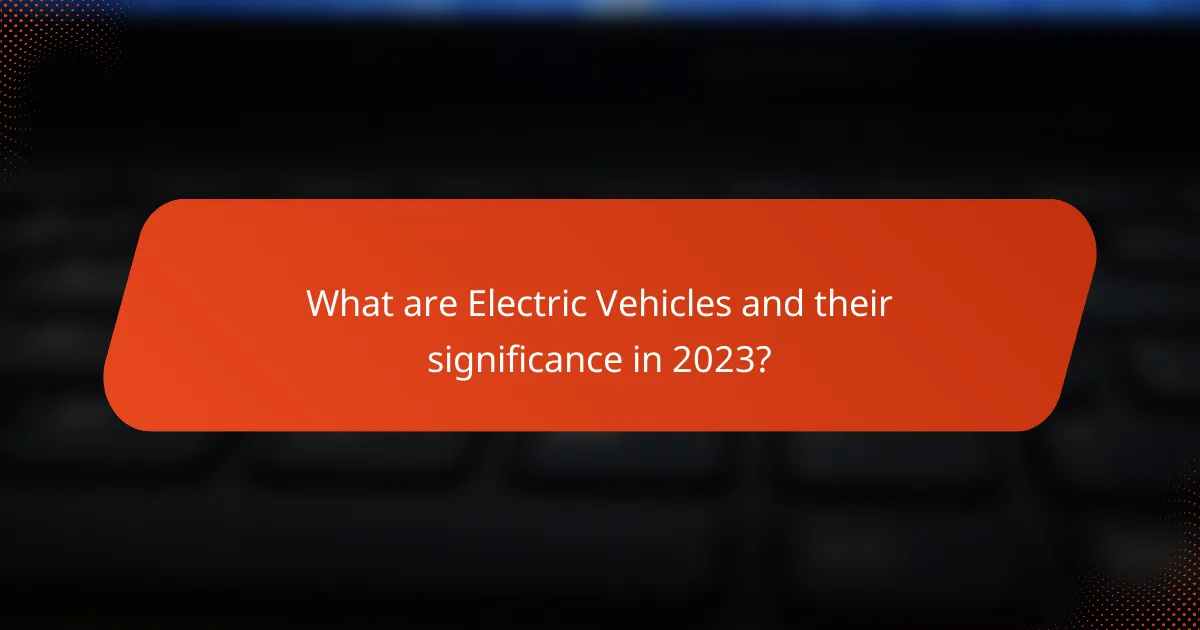
What are Electric Vehicles and their significance in 2023?
Electric vehicles (EVs) are automobiles powered entirely or partially by electricity. They utilize electric motors instead of internal combustion engines. In 2023, EVs play a critical role in reducing greenhouse gas emissions. They contribute to cleaner air quality by producing zero tailpipe emissions. The global EV market is projected to grow significantly, with sales expected to reach 26 million units by 2030. Advances in battery technology have improved range and charging times. Governments worldwide are implementing incentives to promote EV adoption. This shift supports renewable energy integration into transportation. Overall, electric vehicles are essential for sustainable mobility and combating climate change.
How do Electric Vehicles differ from traditional vehicles?
Electric vehicles (EVs) differ from traditional vehicles primarily in their power source. EVs use electric motors powered by batteries, while traditional vehicles rely on internal combustion engines fueled by gasoline or diesel. This fundamental difference leads to various operational and environmental distinctions. EVs produce zero tailpipe emissions, contributing to reduced air pollution. In contrast, traditional vehicles emit greenhouse gases and pollutants during operation. Additionally, EVs typically have lower operating costs due to fewer moving parts and reduced fuel expenses. According to the U.S. Department of Energy, EVs can be three to five times more efficient than conventional vehicles. Furthermore, EVs often feature regenerative braking systems that enhance energy efficiency. Traditional vehicles do not possess this capability, which allows EVs to recover energy during deceleration. Overall, the shift from fossil fuels to electricity represents a significant transformation in the automotive landscape.
What are the key components of Electric Vehicles?
The key components of electric vehicles (EVs) include the electric motor, battery pack, inverter, and charging system. The electric motor converts electrical energy into mechanical energy to drive the vehicle. The battery pack stores energy for the motor and is typically composed of lithium-ion cells. The inverter changes direct current (DC) from the battery into alternating current (AC) for the motor. The charging system allows the EV to connect to a power source for recharging. These components work together to enable the efficient operation of electric vehicles.
How do Electric Vehicles operate?
Electric vehicles (EVs) operate using electric motors powered by rechargeable batteries. These batteries store electrical energy that is converted into mechanical energy by the motor. When the driver accelerates, the electric motor draws power from the battery. Regenerative braking allows the vehicle to recover energy during deceleration. This energy is sent back to the battery, enhancing efficiency. EVs typically use lithium-ion batteries, which offer high energy density. According to the U.S. Department of Energy, EVs can convert over 60% of electrical energy from the grid to power at the wheels. This is significantly more efficient than traditional internal combustion engines.
What technological advances are shaping Electric Vehicles in 2023?
Battery technology advancements are significantly shaping Electric Vehicles in 2023. Solid-state batteries are being developed, offering higher energy density and improved safety. These batteries can potentially double the range of electric vehicles. Fast-charging technologies are also progressing, reducing charging times to under 15 minutes. Wireless charging systems are being tested, enhancing convenience for users. Autonomous driving features are becoming more sophisticated with AI integration. Enhanced connectivity is improving vehicle-to-everything (V2X) communication. These technological strides are making electric vehicles more efficient and appealing to consumers.
What innovations have been made in battery technology?
Recent innovations in battery technology include solid-state batteries, which offer higher energy density and improved safety. These batteries replace liquid electrolytes with solid materials. This change reduces the risk of leaks and fires. Another significant advancement is lithium-sulfur batteries. They can potentially store more energy than traditional lithium-ion batteries. Research indicates they could achieve energy densities of up to 500 Wh/kg. Furthermore, fast-charging technology has improved significantly. Some new batteries can charge to 80% in just 15 minutes. Recycling processes for batteries have also advanced. They now recover up to 95% of materials, reducing waste. These innovations enhance the performance and sustainability of batteries in electric vehicles.
How is software integration transforming Electric Vehicles?
Software integration is transforming Electric Vehicles (EVs) by enhancing connectivity and functionality. It allows for real-time data processing and communication between vehicles and infrastructure. This integration facilitates features like over-the-air updates, improving vehicle performance and security. Additionally, software integration enables advanced driver-assistance systems (ADAS), making EVs safer and more efficient. According to a report by McKinsey, software-driven features are expected to account for up to 30% of the value in future EVs. Furthermore, it supports energy management systems that optimize battery usage and charging. This transformation results in a more sustainable and user-friendly driving experience.
What are the environmental benefits of Electric Vehicles?
Electric vehicles (EVs) provide significant environmental benefits. They produce zero tailpipe emissions, reducing air pollution in urban areas. EVs contribute to lower greenhouse gas emissions compared to traditional gasoline vehicles. According to the U.S. Environmental Protection Agency, EVs can reduce carbon dioxide emissions by up to 60% over their lifetime. They also promote the use of renewable energy sources when charged with green electricity. Additionally, EVs help decrease noise pollution, contributing to quieter urban environments. The shift to electric vehicles can lead to reduced dependency on fossil fuels, supporting energy sustainability.
How do Electric Vehicles contribute to reducing emissions?
Electric vehicles (EVs) contribute to reducing emissions primarily by eliminating tailpipe pollutants. Unlike conventional vehicles, EVs run on electricity, which can be generated from renewable sources. This significantly decreases greenhouse gas emissions compared to gasoline or diesel vehicles. According to the U.S. Environmental Protection Agency, EVs produce zero tailpipe emissions. Additionally, when charged with renewable energy, their overall lifecycle emissions can be reduced by up to 70%. Studies show that widespread adoption of EVs could reduce carbon dioxide emissions by 1.5 billion metric tons by 2030.
What impact do Electric Vehicles have on energy consumption?
Electric vehicles (EVs) significantly impact energy consumption by reducing overall fossil fuel use. They convert electricity to power with higher efficiency compared to internal combustion engines. According to the U.S. Department of Energy, EVs can convert over 60% of electrical energy from the grid to power at the wheels. In contrast, conventional gasoline vehicles only convert about 20% of the energy stored in gasoline.
As EV adoption increases, the demand for electricity rises. This shift can lead to changes in energy production, favoring renewable sources. A study by the International Energy Agency (IEA) indicates that widespread EV use could lower global oil demand by 2.5 million barrels per day by 2030.
Moreover, the charging patterns of EVs can influence peak electricity demand. Smart charging solutions can help manage this demand effectively. Overall, EVs promote a more sustainable energy landscape by enhancing energy efficiency and supporting cleaner energy sources.
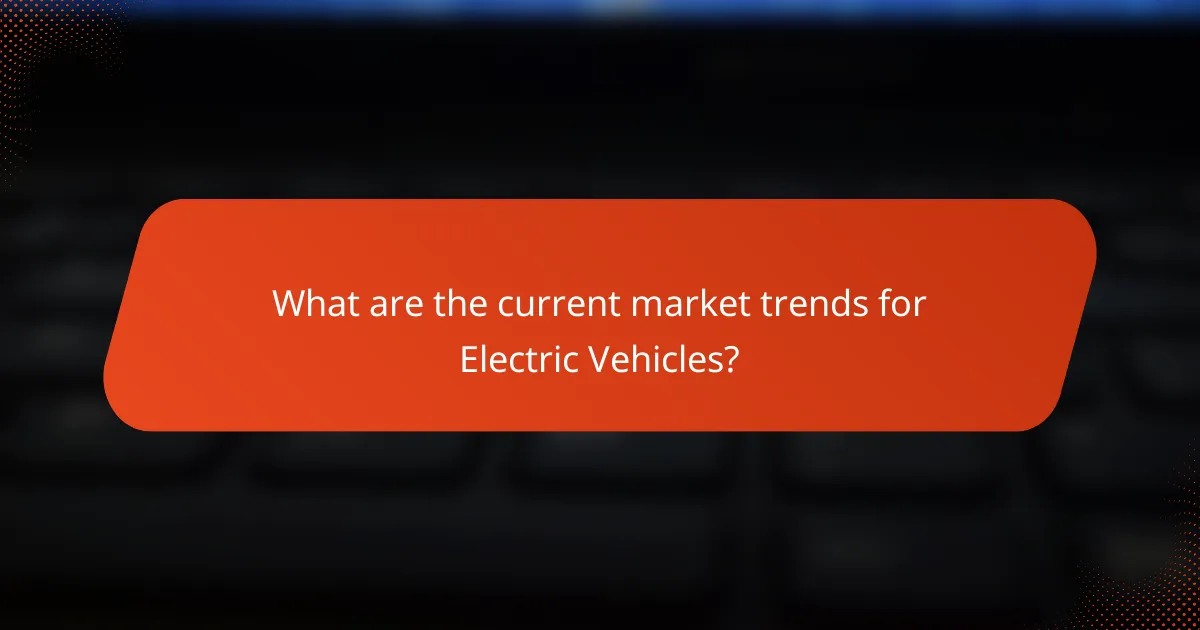
What are the current market trends for Electric Vehicles?
The current market trends for Electric Vehicles (EVs) indicate significant growth and adoption. Global EV sales surged by 108% in 2021, reaching 6.6 million units. This trend continued into 2022, with projections suggesting that EV sales could account for 25% of the global automotive market by 2025. Major manufacturers are expanding their EV offerings, with over 500 new models expected by 2025. Government incentives and regulations are driving consumer interest and investment in EV infrastructure. Additionally, advancements in battery technology are improving range and reducing costs. These factors collectively contribute to the increasing market share of electric vehicles.
How is consumer demand evolving for Electric Vehicles in 2023?
Consumer demand for Electric Vehicles (EVs) is increasing significantly in 2023. A recent report from the International Energy Agency indicates that global EV sales surged by 60% in the first half of 2023 compared to the previous year. This growth is driven by rising environmental awareness and government incentives. Many consumers are prioritizing sustainability in their purchasing decisions. Additionally, advancements in battery technology are improving EV performance and reducing costs. The average price of EVs has dropped by approximately 15% since 2022. Charging infrastructure expansion is also making EV ownership more convenient. These factors contribute to a robust upward trend in consumer interest and adoption of electric vehicles.
What demographic factors influence Electric Vehicle adoption?
Demographic factors influencing Electric Vehicle (EV) adoption include income level, education, age, and geographic location. Higher income individuals are more likely to purchase EVs due to the initial cost. Education level affects awareness and understanding of EV benefits. Younger consumers tend to be more environmentally conscious and open to new technologies. Geographic location plays a role, as urban areas often have better charging infrastructure. According to a study by the International Council on Clean Transportation, over 50% of EV buyers in the U.S. have a household income above $100,000. This data illustrates the correlation between income and EV adoption rates.
How are Electric Vehicle sales performing globally?
Electric vehicle sales are experiencing significant growth globally. In 2022, approximately 10 million electric vehicles were sold worldwide, marking a 55% increase from the previous year. This trend is driven by increasing consumer demand and government incentives. Major markets include China, Europe, and the United States. China alone accounted for over half of global sales, with 6.9 million units sold. Europe saw a rise in market share, with electric vehicles comprising 20% of new car sales. The U.S. market is also expanding, with electric vehicle sales increasing by 70% in 2022. Analysts predict that by 2025, electric vehicle sales could reach 25 million annually. This growth reflects a broader shift towards sustainable transportation and reduced carbon emissions.
What role do government policies play in the Electric Vehicle market?
Government policies significantly influence the Electric Vehicle (EV) market. They shape the regulatory framework that governs EV production and sales. Incentives such as tax credits encourage consumers to purchase EVs. For instance, the U.S. federal tax credit can provide up to $7,500 for eligible electric vehicles. Policies also mandate emissions standards, pushing manufacturers to develop cleaner technologies. Countries like Norway have set ambitious targets for EV adoption, aiming for all new cars to be zero-emission by 2025. Infrastructure support, such as funding for charging stations, enhances EV accessibility. Additionally, government investments in research and development foster innovation in battery technology. Overall, these policies drive market growth and consumer acceptance of electric vehicles.
What incentives are being offered for Electric Vehicle purchases?
Incentives for Electric Vehicle purchases include federal tax credits, state rebates, and grants. The federal government offers a tax credit of up to $7,500 for eligible electric vehicles. Many states provide additional rebates that can range from $1,000 to $5,000. Some local municipalities also offer incentives such as reduced registration fees or access to carpool lanes. Additionally, utility companies may provide rebates for home charging equipment. These incentives aim to encourage the adoption of electric vehicles and reduce greenhouse gas emissions.
How are regulations affecting Electric Vehicle manufacturers?
Regulations are significantly shaping Electric Vehicle manufacturers by enforcing stricter emissions standards. These standards compel manufacturers to innovate and invest in cleaner technologies. For example, the European Union has set a target to reduce CO2 emissions from new cars by 55% by 2030. Compliance with these regulations often requires substantial research and development funding. Additionally, some regions offer incentives for electric vehicle production, which can offset costs. Manufacturers must also adhere to safety regulations that impact design and production processes. Non-compliance can lead to hefty fines and market access restrictions. Thus, regulations drive both challenges and opportunities for Electric Vehicle manufacturers.
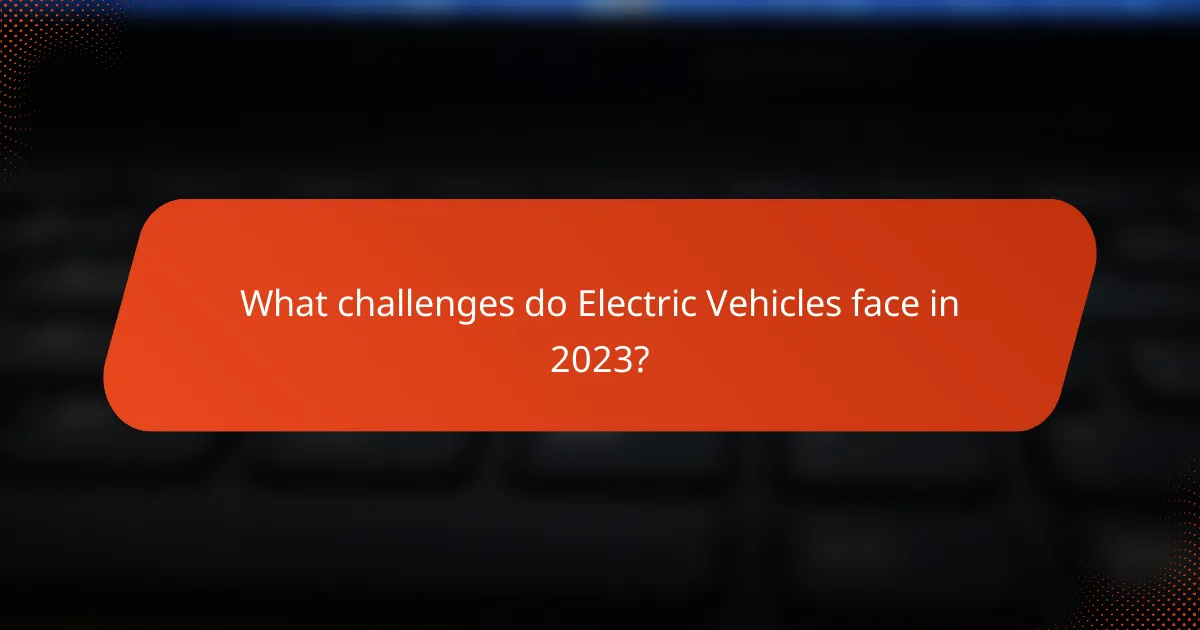
What challenges do Electric Vehicles face in 2023?
Electric vehicles face several challenges in 2023. One major challenge is the limited charging infrastructure. Many regions still lack sufficient charging stations for widespread adoption. Another issue is battery technology. Current batteries can be expensive and have limited range. This affects consumer confidence in electric vehicles. Additionally, there are supply chain disruptions. These can delay the production of electric vehicles and their components. High upfront costs also remain a barrier for many potential buyers. Lastly, competition from traditional vehicles continues to pose a challenge. These factors collectively hinder the growth of the electric vehicle market in 2023.
What are the common misconceptions about Electric Vehicles?
Common misconceptions about electric vehicles include the belief that they have limited range. Many electric vehicles can travel over 300 miles on a single charge. Another misconception is that charging takes too long. Fast chargers can recharge a vehicle to 80% in about 30 minutes. Some people think electric vehicles are too expensive. The total cost of ownership can be lower due to savings on fuel and maintenance. Additionally, there is a belief that electric vehicles are not powerful. Many models offer impressive acceleration and torque. Lastly, some believe that electric vehicles are not environmentally friendly. They produce zero tailpipe emissions, significantly reducing air pollution.
How does range anxiety affect consumer perceptions?
Range anxiety significantly affects consumer perceptions of electric vehicles (EVs). Consumers often perceive EVs as less reliable due to concerns about battery range. This anxiety can deter potential buyers from considering EVs as a viable option. A 2021 study by the International Council on Clean Transportation found that 60% of consumers expressed concerns about running out of battery on long trips. This fear can lead to negative attitudes towards EV technology. Additionally, range anxiety may influence consumers to prefer traditional vehicles over electric ones. The perception of limited range can diminish the attractiveness of EVs in the automotive market.
What are the challenges related to charging infrastructure?
Charging infrastructure faces several challenges. One significant issue is the limited availability of charging stations. According to the International Energy Agency, as of 2021, there were only 1.8 million public charging points globally. This scarcity can lead to range anxiety among electric vehicle users. Another challenge is the variability in charging speeds. Different chargers offer various power outputs, which can affect the time needed to recharge vehicles. Additionally, the integration of charging infrastructure with existing electrical grids poses technical difficulties. Many grids are not equipped to handle the increased demand from widespread electric vehicle adoption. Furthermore, investment costs for developing charging networks can be substantial. Public and private funding is essential to expand infrastructure effectively. Lastly, standardization of charging connectors and payment systems remains a hurdle. Lack of uniformity can confuse users and hinder the adoption of electric vehicles.
What are the best practices for maintaining Electric Vehicles?
Regularly check the battery health of Electric Vehicles (EVs). This ensures optimal performance and longevity. Maintain the battery charge between 20% and 80%. Avoid deep discharges to prolong battery life. Schedule software updates as manufacturers release them. Updates can improve efficiency and add features. Inspect tire pressure monthly. Properly inflated tires enhance range and safety. Keep the EV clean, especially the charging ports. Dirt can affect charging efficiency. Monitor brake system performance. Regenerative braking can wear components differently than traditional brakes. Finally, follow the manufacturer’s recommended maintenance schedule. This includes inspections and part replacements as needed.
How can owners maximize battery life in Electric Vehicles?
Owners can maximize battery life in Electric Vehicles by following specific practices. Regularly charging the battery to around 80% instead of 100% can help prolong its lifespan. Avoiding deep discharges, or letting the battery drop below 20%, also contributes to longevity. Using eco-driving techniques, such as smooth acceleration and braking, reduces energy consumption. Keeping the vehicle in moderate temperatures prevents excessive heat or cold from damaging the battery. Additionally, minimizing the use of fast charging can protect battery health over time. Research shows that these practices can extend battery life significantly, potentially by several years.
What routine maintenance should Electric Vehicle owners follow?
Electric Vehicle (EV) owners should follow specific routine maintenance tasks to ensure optimal performance. Regularly check the battery health and charging system. This includes monitoring the battery’s state of charge and ensuring proper charging practices. Inspect tire pressure monthly to maintain efficiency and safety. Rotate tires every 5,000 to 7,500 miles to promote even wear.
Additionally, EV owners should check brake fluid levels and replace them as needed. Clean and replace air filters according to manufacturer recommendations. Regular software updates are crucial for performance improvements and security. Finally, schedule a professional inspection annually to identify any potential issues early on.
What should potential buyers consider before purchasing an Electric Vehicle?
Potential buyers should consider several key factors before purchasing an Electric Vehicle (EV). First, they should evaluate the vehicle’s range on a single charge. Many EVs now offer ranges between 150 to 370 miles. Next, buyers need to assess charging infrastructure availability. According to the U.S. Department of Energy, there are over 100,000 charging stations in the U.S. Buyers should also consider the total cost of ownership. EVs often have lower maintenance costs compared to traditional vehicles. Additionally, potential buyers should review available incentives. Federal and state incentives can reduce the purchase price significantly. Battery life and warranty are also crucial. Most manufacturers offer warranties of 8 years or 100,000 miles for their batteries. Finally, buyers should think about their driving habits. Daily commute distances can impact the suitability of an EV.
Electric vehicles (EVs) are automobiles powered by electricity, playing a crucial role in reducing greenhouse gas emissions and improving air quality in 2023. This article explores the technological advances shaping EVs, including innovations in battery technology and software integration, as well as their environmental benefits, such as zero tailpipe emissions. Additionally, it examines current market trends, consumer demand, and government policies influencing EV adoption, while addressing challenges like charging infrastructure and misconceptions surrounding EVs. Key considerations for potential buyers are also highlighted to provide a comprehensive understanding of the electric vehicle landscape.
